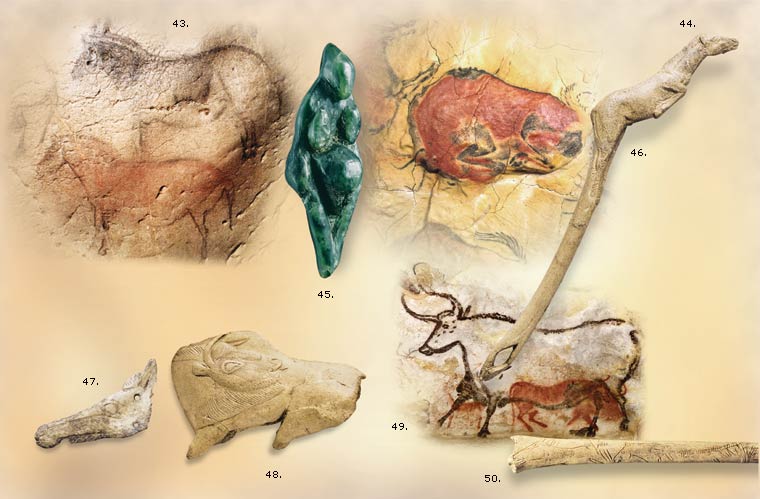Artistic expressions
As well as their day to day activities, human beings also began to display a certain interest in more transcendental matters and the first evidence of abstract reasoning and symbolic behaviour may date back to very remote times. It may have been this development which led people to make rhythmical incisions in certain bones, gather unusual objects such as shells and ochre and give interpretations to certain natural shapes in the rock. However, the symbolic dimension became far more marked during the Upper Palaeolithic era, when Homo sapiens sapiens reached Europe from Africa.
gipuzkoakultura.net


gipuzkoakultura.net
domingo 18 enero 2026
Bertan > The Magdalenian pendants of the Praileaitz I cave(Deba) > Versión en Inglés: Artistic expressions
- 1- Praileaitz I
- 2- The natural setting
- 3- Human beings during the upper Palaeolithic
- 4- Artistic expressions
- 5- Artistic expressions

43. Horses. Ekain Cave (Gipuzkoa). 44. Bison. Altamira Cave (Cantabria). 45. The Losange Venus, (Grimaldi, Liguria), 25,000 years old. 46. Atlatl (or spear thrower) carved from reindeer’s antler, depicting a leaping horse. Montastruc (Tarn-et-Garonne), 14,000-13,000 years old. 47. Horse’s head drilled in hyoid bone from c. 14,000 years before the present. Isturitz (Basse-Navarre). 48. Bison carved on a reindeer’s antler, 14,000 years old. La Madeleine Cave (Dordogne). 49. Aurochs. Lascaux cave (Dordogne). 50. Carved gannet bone, 12,000 years old. Torre Cave (Gipuzkoa). © Xabi Otero
Artistic manifestations from this period were made on a range of media, including both the walls of caves and sheltered rocks and small portable items. The former are mostly preserved in the
shaded or darker areas of the caves, often at some distance from the domestic area or habitation. Because of this apparent distance or concealment, some writers believe that these places were sacred sites where practices or rituals relating to hunting magic, shamanism, etc. were performed.
The latter group, on the other hand, were made on a range of small, and therefore portable, bone like pieces (horns, antlers, bone or ivory) and stones (flat pieces and pebbles). Sometimes the decorations were made on utensils (spears, harpoons, staffs, etc.), while one other occasions they were created on objects with no apparent practical use for domestic chores or hunting.
The techniques used both in this art mobilier and cave or “parietal” art include painting using different types of colouring (ochre for red, manganese and coal for black) and engraving, with carved lines of varying depth. The most frequently represented themes include different species of animal (horses, bison, wild goats, etc.), signs (longitudinal incisions, rhombuses, ovals, arrow shaped or serrated motifs, etc.) and occasionally representations of humans or of different parts of the body (hands, vulvas etc.).
The latter group, on the other hand, were made on a range of small, and therefore portable, bone like pieces (horns, antlers, bone or ivory) and stones (flat pieces and pebbles). Sometimes the decorations were made on utensils (spears, harpoons, staffs, etc.), while one other occasions they were created on objects with no apparent practical use for domestic chores or hunting.
The techniques used both in this art mobilier and cave or “parietal” art include painting using different types of colouring (ochre for red, manganese and coal for black) and engraving, with carved lines of varying depth. The most frequently represented themes include different species of animal (horses, bison, wild goats, etc.), signs (longitudinal incisions, rhombuses, ovals, arrow shaped or serrated motifs, etc.) and occasionally representations of humans or of different parts of the body (hands, vulvas etc.).


